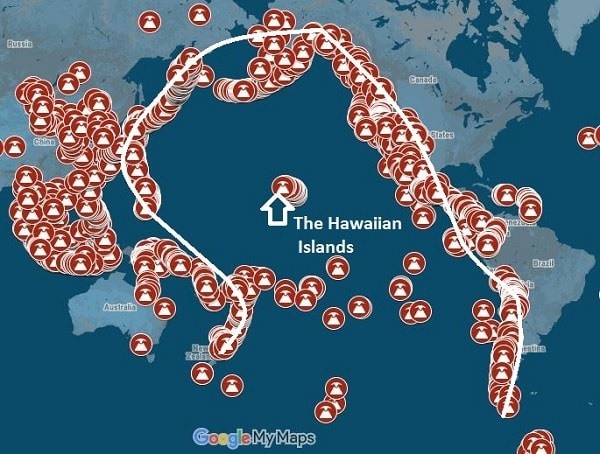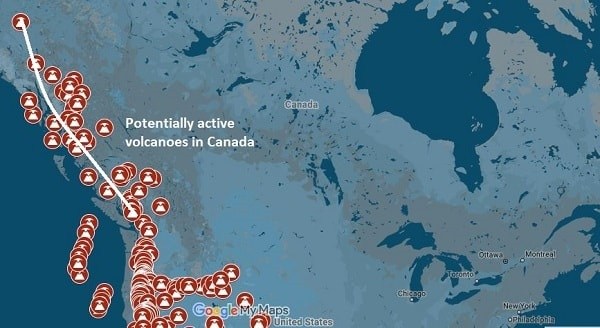Where do volcanoes come from?
A volcano is essentially a vent in the Earth’s surface. But, instead of blowing warm air and keeping your feet toasty (like a vent in your home), a volcano exhausts gases, volcanic ash and lava.
Volcanoes exist because the Earth’s surface (the crust) is made of tectonic plates. Tectonic plates fit together like a floating puzzle and underneath the plates there is a layer called the mantle. The upper layer of the mantle is hard. But the lower layer is starting to melt and this semi-melted rock is called magma.
Tectonic plates move apart and collide causing gaps that create volcanoes. Due to pressure, volcanoes release magma and when magma reaches the surface it is called lava.
via GIPHY
Volcanoes also occur over mantle plumes. Mantle plumes are columns of magma that rise to the Earth’s surface creating a hot spot that forms a volcano. For example, the Hawaiian Islands are formed by a hot spot over a mantle plume.
How many volcanoes are there?
Map showing volcanoes around the world. Select specific volcanoes to learn more about their location and find out what type of volcano it is. Database Source: Global Volcanism Program, 2013. Volcanoes of the World, v. 4.7.0. Venzke, E (ed.). Smithsonian Institution. Downloaded 18 Jun 2018. https://doi.org/10.5479/si.GVP.VOTW4-2013
It is estimated that there are about 1,500 active volcanoes. Volcanoes can be active, dormant or extinct. If a volcano is active it means that it erupted in the last 10,000 years, while a dormant volcano has not erupted in about 10,000 years but will erupt again. A significant number of volcanoes are found in the Pacific Ring of Fire. In the centre of the Pacific Ring you can find Hawaii.

Are there active volcanoes in Canada?
There are several potentially active volcanoes in Canada along the Pacific Ring of Fire. These volcanic areas can be found in British Columbia and the Yukon. These areas have not been active in centuries. However, they all have the potential to be active in the future.

No two volcanoes are made the same
When you think of a volcano you probably think of the tall, prominent volcanoes called composite or stratovolcanoes. But there are many different types of volcanoes including shield volcanoes, cinder cone volcanoes and lava domes.
| Volcano Type |
Shape |
How it is made |
Real World Example |
| Composite/Stratovolcano |
Tall, prominent, pointed peak |
Alternating layers of lava flow, ash and un-melted stone |
Mount Fuji in Honshu, Japan |
| Shield |
Flat, wide, dome-shaped |
Hardened fluid lava flows |
Kilauea in Hawaii, United States |
| Cinder Cone |
Usually short with a bowl-shaped crater |
Congealed lava ejected from a single vent |
SP Crater in Arizona, United States |
| Lava Dome |
Small, bulbous |
Formed from lava that cannot flow because it is too thick |
In the centre of Mount St. Helens in Washington, United States |
What’s the shape got to do with it?
The shape of a volcano usually indicates the type of eruption. For example, the Kilauea volcano that erupted on May 3 in Hawaii is a dome-shaped shield volcano that is 1247 meters tall. Kilauea exhibits an effusive eruption. During an effusive eruption lava flows slowly out of the volcano.
The Kilauea volcano has thin lava and this helps gases escape easily. Since the gases can escape the eruption is less explosive. These eruptions also build and form the shape of the island and these volcanoes because the lava flows and hardens to create the dome-shape.
via GIPHY
By contrast, Guatemala’s Fuego volcano (a stratovolcano 3763 meters tall) has explosive eruptions. An explosive eruption happens because of several different factors. This includes the type of lava. The Fuego volcano (which erupted June 3) has thicker lava that builds on top of the volcano making it harder for gases to escape. This creates more pressure and causes the eruption to be more explosive and dangerous.
This type of explosion also creates pyroclastic flows. Pyroclastic flows happen when the lava contains a lot of gas that cannot rise to the surface because the lava is so thick. These pockets of gas form bubbles. The bubbles escape the lava by popping when they reach the surface. When the bubbles pop they send bits of lava flying everywhere and these are called pyroclasts. Pyroclastic flows move very quickly and contain bits of lava, ash and gas.
via GIPHY
Volcanoes with explosive eruptions form into iconic stratovolcanoes (that we are all familiar with) because the lava layers harden to create tall peaks.
How the Red Cross is helping in Hawaii and Guatemala
Even though Kilauea is undergoing an effusive eruption, with more than 470 homes destroyed it is still extremely dangerous. The American Red Cross is helping by providing shelter, comfort and supplies.
The devastating Guatemalan Fuego volcano is still experiencing minor eruptions daily. It is estimated that 197 people are missing and approximately 110 people passed away because of this eruption. The Guatemalan Red Cross is working hard and providing affected residents with medical and psychological support.
The Red Cross Restoring Family Links program is key to reconnecting families and loved ones during these situations.